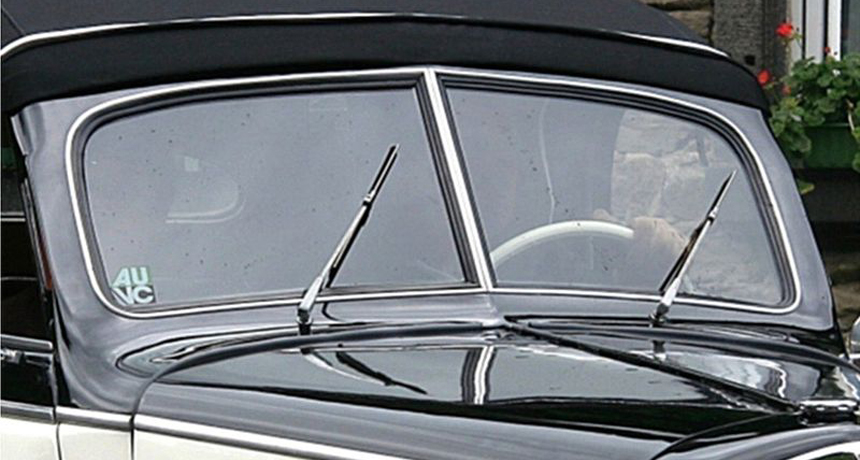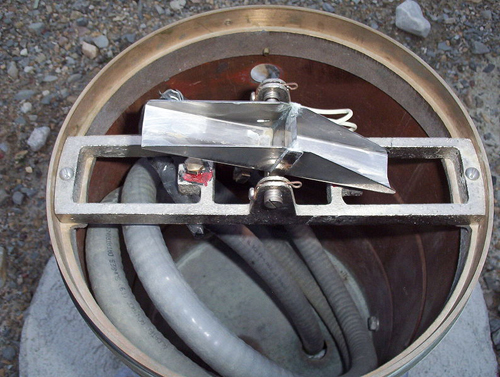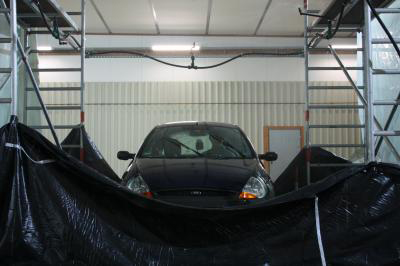Measuring rain with your windshield wipers

Windshield wipers help keep the rain off, but they could also tell us how much rain there is, and how fast its falling.
Lothar Spurzem/Wikimedia Commons
Do you have a rain gauge in your yard or at your school? They are handy devices to teach students about rainfall over time. The simplest ones look like test tubes. A fancier type, a traditional tipping bucket rain gauge, gathers water in a funnel and pours it on the higher end of a little seesaw. Every time the seesaw fills with water and tips, it makes an electrical “mark.” By looking at the number of marks and how close together they are, a scientist can tell both how much rain fell and how fast it was falling.
These rain gauges work pretty well. But they are only in one place at one time. This means you’d have to have a lot of rain gauges to figure out how much rain was falling over, say, your whole town. Is there a convenient way to find out how much rain is falling over a wide area?
Ehsan Rabiei and his colleagues wanted to see if they could use a car’s windshield wiper speed to measure rainfall. Think of your wipers when it’s raining. If it’s not raining very hard, you run your windshield wipers slowly, so they wipe off the windshield only once in a while. As it rains harder, you have to turn the wiper speed up so they run faster. If it’s raining really hard, you turn your wipers up to their fastest pace. The speed you need to run the wipers is associated with how much rain is hitting the windshield. So

To look at this, Rabiei and the other scientists set up an artificial rain system in their lab. It’s basically a giant sprinkler system, elevated off the ground. The sprinkler system could work under different pressures, which allowed the scientists to control how much “rain” was falling. Low pressure meant a little rain, falling lightly. Higher pressure meant a lot of rain, falling hard.
The scientists parked a car under this sprinkler system, with windshield wipers at the ready. They also put a traditional tipping bucket rain gauge and several other types of rain gauges for comparison.
In their study, published in the November 28 issue of Hydrology and Earth System Sciences, the scientists found that the speed of the windshield wipers required so you could see was predictably tied to how heavy the rain was. When a person in the car adjusts wiper speed so they can see, they do it according to how much rain is falling and how fast. Heavier rain, Faster wipers. The scientists then came up with an equation that predicted the amount of rain from the speed of the wipers.
This worked best when there was a person controlling the wiper speed. The scientists also tested automatic windshield wipers. These wipers have a sensor in them that can tell when there is water on the windshield, and adjust the wiper speed on their own. Many modern cars have these automatic wipers in them.

Why do we need to measure rainfall? Rainfall determines what crops can be grown where, and where animals can graze. But it’s also important know how fast rain is falling as well. This is especially important when you are trying to figure out if an area might flood, and how to prevent it from flooding. “One simple example is a dam,” Rabiei says. “If we want to design a dam we have to know how much rain we are dealing with. If you don’t know how much rain falls, and can’t predict how much will fall in the future, you can’t design it appropriately.”
In addition to dams, cities design drainage systems to carry water away, to stop it from flooding the streets. How do you know if you have enough drains and big enough sewers to take care of the water in a city? You need to know how much rain falls.
Of course, Rabiei’s study was done in a laboratory. It’s just the first step. Now, Rabiei and his colleagues are testing the cars outside, in real conditions. They are trying to deal with issues like how fast the car is going. This can affect how much rain hits the car, and how fast and hard it hits the rain sensors. They also have to deal with other problems. What if there is a lot of wind? Or what if the car is under some trees? Different conditions can change how well the cars can predict rainfall. But if they can work out all the issues, the data from the cars could help design better dams and drainage systems.
The next time you are in a car and it’s raining, watch your wipers (only do this if you are in the passenger seat!). Does the driver change the speed as the rain increases? Do you use an automatic sensor instead? See if you can use wiper speed to determine rainfall. Does it change as the car speeds up and slows down? What about if you’re under some trees? Collect your own data and see how well your windshield wipers measure rainfall. They could be used for more than just wiping the rain away.
Power words
GPS device This system uses devices that calculate their position (in terms of latitude and longitude) from any place on the ground or in the air. They do this by comparing how long it takes signals from different satellites to reach them.
graduate student Someone working toward an advanced degree by taking classes and performing research. This work is done after the student has already graduated from college (usually with a four-year degree).
hydrology The study of where water is on earth, how it moves, and what it is like. This can be water on the surface in oceans, lakes or rivers, or water below the ground.
sensor a measurement device that takes a measure of something and converts it to a signal that someone can read. For example, a sensor might measure rain on a surface, and convert that to a signal to turn windshield wipers on.